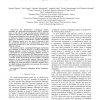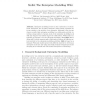329 search results - page 59 / 66 » Formal Support for Representing and Automating Semantic Inte... |
LOGCOM
2007
13 years 7 months ago
2007
Categorisation of objects into classes is currently supported by (at least) two ‘orthogonal’ methods. In logic-based approaches, classifications are defined through ontologi...
KBSE
2009
IEEE
14 years 2 months ago
2009
IEEE
—In the Model-Driven Architecture (MDA) paradigm the Query/View/Transformation (QVT) standard plays a vital role for model transformations. Especially the high-level declarative ...
ESWS
2009
Springer
14 years 2 months ago
2009
Springer
Abstract. Enterprise modelling focuses on the construction of a structured description, the so-called enterprise model, which represents aspects relevant to the activity of an ente...
IEEEICCI
2003
IEEE
14 years 1 months ago
2003
IEEE
Abstract— An ontology is a formal language adequately representing the knowledge used for reasoning in a specific environment. When contradictions arise and make ontologies inad...
SP
1998
IEEE
14 years 4 days ago
1998
IEEE
A strand is a sequence of events; it represents either the execution of legitimate party in a security protocol or else a sequence of actions by a penetrator. A strand space is a ...


